Growing
up in Palo Alto, I always wanted to be an artist. Even though I was
encouraged as a child to draw, paint and sculpt, I was never one of
those
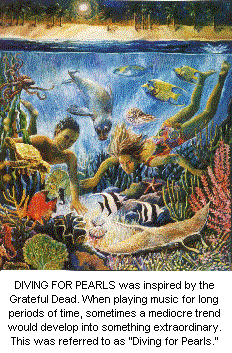
super-drawing
kids in school. But I did see pictures in my mind. I remember lying
in bed with my mother, thinking her back as a television screen, and
I could see pictures in her back. My middle-class
family thought painting was no way to make a living, so I didn't have
any reason to think I could make a living from art. For years I just
kept doing other things for work, trying to be responsible, but in my
spare time, I would paint and draw—mostly portraits of people and animals.
After I graduated from high school, I moved to Lake Tahoe
and worked as a nurse's aide; then went to DeAnza College and later
San Jose State, where I took classes to become a registered nurse. At
one point, I thought I might become a marine biologist because I enjoyed
nature and the ocean so much. However, after a few diving trips, I realized
I wasn't all that comfortable under water.
Artists were always the people I wanted to hang out with,
but in college, where art was presented as being really strict and formal,
I actually flunked out of an art class. We had to things like make color
charts with a hundred shades of gray from white to black. I could never
do art with my left brain. I realized that way of learning art was not
going to be my way. My way is just doing it. At age twenty-five I attended
the Academy of Arts in San Francisco. That was when I finally made the
decision to become an artist. I felt really good about that decision;
it was like shedding a false skin.

I had a teacher, Carlos Loarca from Guatemala, who taught at the Mission
Cultural Center in San Francisco. He was such an individual—a very
intuitive kind of artist. I learned a lot just from being around him.
Art was his whole life; he inspired me so much. Once he said to me,
"You know how to draw and paint well enough. Now you just have to
go and make the pictures." He also told me, "A painting is done in
a half an hour. All the rest is fooling around and filling in the
details." I like this concept because it helps me not get so bogged
down. Many of my paintings take at least a month to complete
because I put in so much detail in them, even though the real core
of the painting is done quickly .
I read somewhere that if you just go into your studio
and sit for eight hours, that's fine. Normally I meditate and smudge
with sage smoke before I paint. I really like to be in the mystical
realm while I work.
When I begin, I cover the canvas with one color and do
what is call "painting from the middle ground." As I pick out the
lights and darks, the picture begins to emerge—much the way Michelangelo
described seeing the statue within the rock. I do sketches as a warm-up
before I begin, but when I start painting the canvas I stay open.
I don't have to be a slave to the study, but just allow the form to
appear. For me, painting comes down to moving the color around on
the canvas. Even though the ideas are meaningful, color is what really
sends me. I love the Fauvists' use of color—they were a part of the
expressionist movement in the 1890s. Colors and shapes moving together
put me into a trance. Painting for me is not chaotic, or about crisis;
it's sublime.
I've been a painter for at least twenty years now. Most
of my work is done in oil, but I also do etchings. I've worked my
discipline to the point where it feels like a habit. One thing I learned
from art school was to keep sketchbooks and diaries. I've created
about fifty of these, and I still get nourished from them. Anais Nin,
an early influence, also kept diaries. The way she related to her
life inspired me, and I springboarded off what she did with words—except
I use visual images. Whenever I come up with something inspiring—dreams,
quotes or images—they go in my sketchbook. These have kept me going
for years. I illustrate my own dreams and others'. For instance, I
have an etching of Aphrodite that came from a dream. She's on the
classic half-shell, with dolphins swimming beneath her in the ocean.
The ocean is like the subconscious, and the dolphins are the messengers.
This blend of personal and collective mythology is typical of my work.
If I were only using my right brain, I'd be in outer
space and not long in this world. While I do my art with my right
brain, I also love computers, and find comfort in left-brain activities.
Logic and order are a nice balance for all the mysticism in my art.
Having to turn in assignments every week in art school taught me discipline
and provided grounding. My physical body is also a big factor in staying
balanced. As a child, I was on a swim team and had to swim laps. Now
I do yoga, jogging and meditation.
My children also ground me. Not having had them too close
together has helped me to keep working, and my husband, Tom Kelly,
entertains the children while I paint. Tom encourages me, and shows
me how to market and talk to people about my art. He spent several
years in the Far East, and shares what he learned there. We have a
good life. Tom is interested in a lot of the same things I am, and
does arts and crafts as well. He makes Tibetan medicine bracelets.
His ideas, feedback and comments help my work.
 Georgia O'Keefe never let anyone see her work until she finished it,
but since I live with my family, I can't do that. Even though I don't
like much feedback when I'm working, I've learned to discriminate
between what's helpful and what isn't. Some people will say it's not
"pure" if other people's comments influence your work, but I do appreciate
what I learn from others. Some people need total isolation, but semi-solitude
works for me. The hard part is finding time to complete my work while
cooking, keeping house, making lunches, and meeting deadlines and
commitments. But I think everyone deals with that no matter who they
are.
Georgia O'Keefe never let anyone see her work until she finished it,
but since I live with my family, I can't do that. Even though I don't
like much feedback when I'm working, I've learned to discriminate
between what's helpful and what isn't. Some people will say it's not
"pure" if other people's comments influence your work, but I do appreciate
what I learn from others. Some people need total isolation, but semi-solitude
works for me. The hard part is finding time to complete my work while
cooking, keeping house, making lunches, and meeting deadlines and
commitments. But I think everyone deals with that no matter who they
are.
My marriage is a cornerstone of my spirituality. Tom
and I have been married fourteen years. With three children life does
get challenging, but I think that's good. The challenges keep me going.
A certain amount of tension gives form to my life. It's another way
of balancing. Anais Nin said, "The personal life that's lived deeply
always extends beyond itself." I feel that what you devote yourself
to reaches the universal ground. For us life is about following our
bliss rather than selling out to corporate America. It's great when
people can do grassroots things to survive, and actually make it.
The more people do the things they love, the better off society will
be. Money is available, and there are ways of accessing and translating
it through art and creativity. Even when I was paranoid and thinking
I should have a "real" job, I knew that was my false self talking.
A friend recently gave us a couple of little books, Don't Worry; Make
Money and Don't Sweat the Small Stuff—and It's All Small Stuff. These
are good for overcoming momentary depression. They express how this
is just a mood swing, like when the weather goes bad—you don't have
to base your life on it. Life can get scary, but somehow the universe
provides.

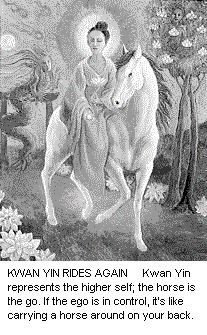 Rock
and roll in the sixties affected my life in a deep way. My girlfriend's
father owned a music store in Palo Alto—Drapers Music Center—and
sold guitars to famous musicians. The whole flavor of the music and
art around that time influenced me. The culture of Haight-Ashbury
was so vibrant. I painted portraits of rock stars like Mick
Jagger and did paintings inspired by songs such as Bob Dylan's "Joker
Man Dance." More recently I was commissioned to do a portrait of Jerry
Garcia, and I listened to tapes of his music as I painted. Even though
I grew up right around the Grateful Dead, I never really appreciate
the beauty of their music until I painted that portrait.
Rock
and roll in the sixties affected my life in a deep way. My girlfriend's
father owned a music store in Palo Alto—Drapers Music Center—and
sold guitars to famous musicians. The whole flavor of the music and
art around that time influenced me. The culture of Haight-Ashbury
was so vibrant. I painted portraits of rock stars like Mick
Jagger and did paintings inspired by songs such as Bob Dylan's "Joker
Man Dance." More recently I was commissioned to do a portrait of Jerry
Garcia, and I listened to tapes of his music as I painted. Even though
I grew up right around the Grateful Dead, I never really appreciate
the beauty of their music until I painted that portrait.
These days I listen more to classical music, and songs by people like
Peter Gabriel, Bruce Cockburn and Sting. I think I've replaced the
music scene with nature. The land speaks to me. I lived in a house
under osprey nests when I moved here, and I love the wildlife—the
deer, the ravens, the foxes. There is a presence in nature—not just
the animals, but the trees and plants. For me, sitting under a redwood
tree is a mystical experience. If I didn't have a family I would probably
be more eco-militant.
My soul is nourished by free-spiritedness.
I hope this comes through my paintings. I don't think I could be an
artist without the ideas and music that have inspired my creations.
I remember Joni Mitchell saying, "Inspiration is the best discipline."
She also said that you never know where inspiration is going to come
from. A big part of what made me want to paint was wanting to bring
out the ancient traditions and the wisdom of women. I've always felt
very strongly that women need to express themselves creatively and
listen to their inner voice. We need to integrate more of the ancient
wisdom into our psyches to balance the high-tech developments of the
past hundred years. There is too much concentrated power, without
the wisdom to use it. As mothers and nurturers, we women have a lot
to say, and our voices help create a balance of power.
I also found much of what I was searching for by studying
the psyche. Early in life, I gained the identity of Wolf Woman. When
I was thirteen, I got a German shepherd named Bruiser who stayed with
me for fourteen years. In high school, since I always had this big
dog with me, they called me Wolf Woman. One of the first shamanic
images I made was a woman's face with a wolf head on top. I learned
about connecting with the animal or nature side of myself by reading
people like Carl Jung, Joseph Campbell and Lynn Andrews. She was one
of the first women I knew of who studied shamanism and voiced the
ancient wisdom. Some Native Americans take offense at her and other
white people who honor their traditions. They see this as ripping
off their culture. I don't see it this way. I don't want to rip off
a tradition; I want to honor what is there and try to learn from it.
When I grew up, I didn't have any spiritual traditions. I am drawn
to the direct connection to spirit that shamanism offers—rather than
going through a priest or anyone else. Art was my way of connecting
to the inner soul, before I ever even heard about shamanism and, like
Joseph Campbell, I love to draw parallels between mythologies.

We
need to find a balance between the inner and the outer worlds. There
is a danger of being too open—this happened to Van Gogh. Sometimes,
when people are too 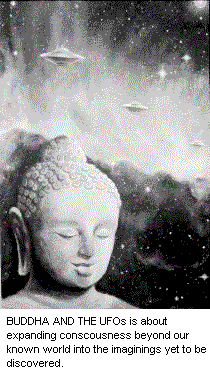 open
in a culture that doesn't support them, they become like hothouse
flowers exposed to the elements. But they pave the way for others
to come through. Then there are people like Georgia O'Keefe. I don't
think she gave a damn what people thought of her paintings. Some people
are just tough like that. My family and responsibilities keep me from
going too far in either direction, so I stay in a comfortable range.
open
in a culture that doesn't support them, they become like hothouse
flowers exposed to the elements. But they pave the way for others
to come through. Then there are people like Georgia O'Keefe. I don't
think she gave a damn what people thought of her paintings. Some people
are just tough like that. My family and responsibilities keep me from
going too far in either direction, so I stay in a comfortable range.
I study and garner strength from the works of spiritual masters like
Neem Karoli Baba. I have also studied the Ramayana, a great Hindu
story that centers around King Ram, Queen Sita, and their devoted
servant Hanuman, the Monkey King. To me Hanuman is the ego at its
highest level. Ram and Sita are like the yin and yang of the higher
self. In this way, the ego serves the higher self.
My painting, "Kuan Yin Rides Again," in which Kuan Yin
rides a horse, came from a Vietnamese woman sage who teaches that
when your life works smoothly, the ego is like the horse and the higher
self is the rider. But when your ego starts to control or push your
higher self around, it's like carrying a horse around on your back.
So I use spiritual teachings to help me and inspire me. When I am
out of balance, it's usually due to an ego trip. When I meditate and
my ego blends into the background, everything is okay.
Over the last couple of years I've been inspired by Angeles
Arrien, a Basque woman. One of her apprentices, Nancy Feehan, lives
here on Seaview Ridge, above Timber 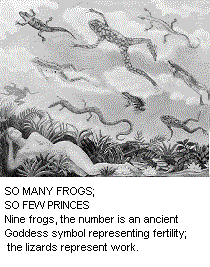 Cove.
I've taken a couple of her yearlong group trainings. These lessons
dovetail with my artwork. In the Basque tradition, they do a tobacco
pouch ceremony once a year, putting things in it that symbolize what
they want to get rid of, and then toss it out. They do other things
like thinking of all the ways you can hurt yourself, writing these
on a knife and burying it. They also make a prayer stick wrapped with
yarn of different colors. Green represents prosperity or abundance
in nature, black represents the West, and so forth. This stick is
planted in the ground; it's like planting your prayers for a year.
Another thing they do involves seven rocks—four on the bottom represent
your grandparents, two above them are for your parents, and
the one on top is you. This ancestor pile provides a way of communicating
with your ancestors. You can make offerings of food and water there.
Doing this helps retrieve lost aspects of ourselves, our soul. The
art I've done based on what I've learned from this group has been
very nurturing.
Cove.
I've taken a couple of her yearlong group trainings. These lessons
dovetail with my artwork. In the Basque tradition, they do a tobacco
pouch ceremony once a year, putting things in it that symbolize what
they want to get rid of, and then toss it out. They do other things
like thinking of all the ways you can hurt yourself, writing these
on a knife and burying it. They also make a prayer stick wrapped with
yarn of different colors. Green represents prosperity or abundance
in nature, black represents the West, and so forth. This stick is
planted in the ground; it's like planting your prayers for a year.
Another thing they do involves seven rocks—four on the bottom represent
your grandparents, two above them are for your parents, and
the one on top is you. This ancestor pile provides a way of communicating
with your ancestors. You can make offerings of food and water there.
Doing this helps retrieve lost aspects of ourselves, our soul. The
art I've done based on what I've learned from this group has been
very nurturing.
People have offered to do past-life regressions with
me but, at this point in life, this doesn't seem necessary. I like
being here and now—letting the mystery be. My work has qualities of wildness and mystery. I believe our souls require
that. In talking about God, you can only point, but you can't put
your finger on it. We just have to be with the unknown. The meanings
of my paintings are also unknown. They change for me over time. If
you look at a painting in a room during the day, over the season,
or over the years, it changes its character. An original piece of
fine art does that. Sometimes I won't like a piece at first but then,
with time, I'll learn to love it. It's similar to the relationships
you have with people.
has qualities of wildness and mystery. I believe our souls require
that. In talking about God, you can only point, but you can't put
your finger on it. We just have to be with the unknown. The meanings
of my paintings are also unknown. They change for me over time. If
you look at a painting in a room during the day, over the season,
or over the years, it changes its character. An original piece of
fine art does that. Sometimes I won't like a piece at first but then,
with time, I'll learn to love it. It's similar to the relationships
you have with people.
My painting "Buddha and the UFOs" didn't have any high
mystical meaning to me when I painted it, but it does now. I made
it ten years ago. Recently I was inspired by a book called Earth—the
Pleiadian Keys to the Living Library. Bear and Company published it.
It's a very interesting book about the relationship of the chakras
to outer space. It relates to our cosmos and universe rather than
just to our planet. This view makes our planet seem even more precious.
Each piece of grass is like a huge library—full of information, mystery
and wonder. The little things that people tend to take for granted
are the same. That painting reaches beyond the smallness of our provincial
mentality and religions, to a broader spectrum of truth.
My work is about introspection and bringing
inner treasures outside. Going within is like the bear entering its
cave. I would like to set an example for people to do that in whatever
way they can—like the Shabbat in the Jewish tradition, where you
forget worldly affairs and just tend to God. That's what art and creativity
are to me—tending to the inner spiritual needs. Wherever that takes
you, it'll be fine, as long as it doesn't hurt anyone. I like to keep
in mind the Hippocratic law of "first do no harm." The Dali Lama says
to treat all sentient beings like your mother. If it weren't for the
kindness of the people who raised you, you wouldn't have made it here.
So I try to be kind to others, meanwhile being loving, trusting and
respecting of myself. Kindness and creativity go hand-in-hand. They
both require nurturing the spirit. Kindness—which comes from inner
strength and compassion, and creativity, which is nothing less than
making light the deepest darkest recesses of the psyche—are innate
in us all with them there is unlimited potential.
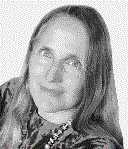 Suzanne
deVeuve lives in Cazadero with her husband and their three children,
ages 13, 9 and 2. Her paintings have appeared in magazines and books.
She has illustrated covers for Z Budapest's A Holy Book of Women's
Mysteries, Grandmother of Time and its sequel Grandmother Moon. She
has also designed covers for The Return of Pahana, by Robert Boissiere
and The Alchemist's Almanac. Her illustrations have appeared in Women's
Spirituality Calendar, Darshan magazine, SageWoman, Sojourn and other
publications. Her line of greeting cards are available in select stores
or by contacting her.
Suzanne
deVeuve lives in Cazadero with her husband and their three children,
ages 13, 9 and 2. Her paintings have appeared in magazines and books.
She has illustrated covers for Z Budapest's A Holy Book of Women's
Mysteries, Grandmother of Time and its sequel Grandmother Moon. She
has also designed covers for The Return of Pahana, by Robert Boissiere
and The Alchemist's Almanac. Her illustrations have appeared in Women's
Spirituality Calendar, Darshan magazine, SageWoman, Sojourn and other
publications. Her line of greeting cards are available in select stores
or by contacting her.
Suzanne deVeuve, P.O. Box 1619,
Gualala, CA 95445, (707) 847-3902email:[sdeVeuve@mcn.org], website:
http://www.deveuve-kelly.com

 super-drawing
kids in school. But I did see pictures in my mind. I remember lying
in bed with my mother, thinking her back as a television screen, and
I could see pictures in her back. My middle-class
family thought painting was no way to make a living, so I didn't have
any reason to think I could make a living from art. For years I just
kept doing other things for work, trying to be responsible, but in my
spare time, I would paint and draw—mostly portraits of people and animals.
super-drawing
kids in school. But I did see pictures in my mind. I remember lying
in bed with my mother, thinking her back as a television screen, and
I could see pictures in her back. My middle-class
family thought painting was no way to make a living, so I didn't have
any reason to think I could make a living from art. For years I just
kept doing other things for work, trying to be responsible, but in my
spare time, I would paint and draw—mostly portraits of people and animals.